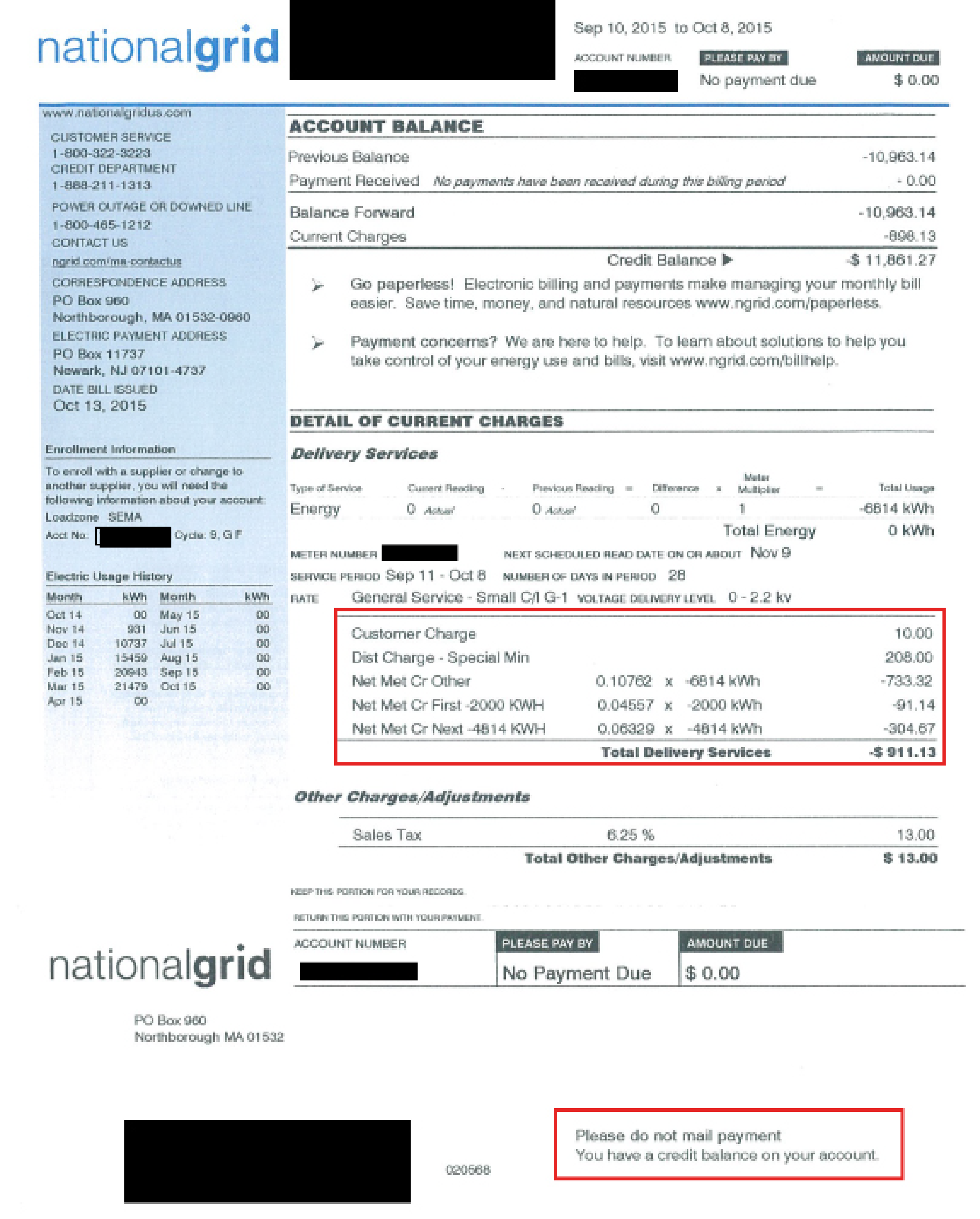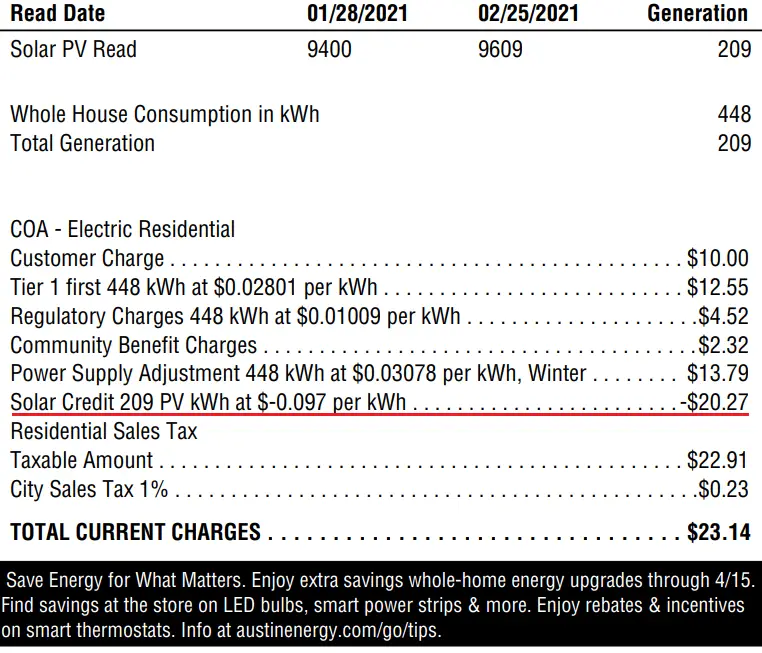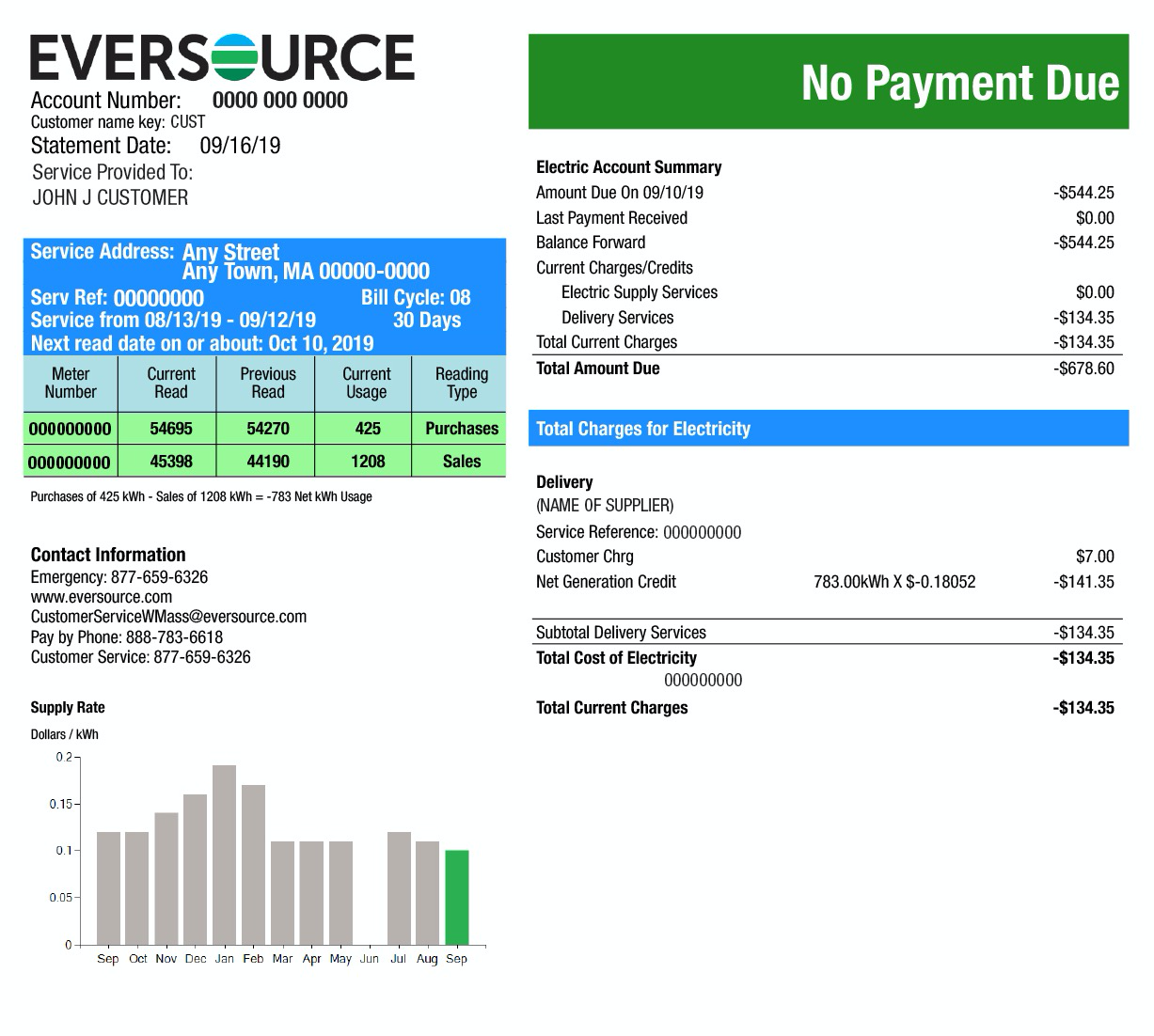Your Main Electricity Charges
Rates. Residential RatesBaseline Credit
Charges For Electricity Services: Purchased Vs Sold
Page 3 of your APS breaks down all the costs and charges that make up your electric bill. On the right-hand column, youll see the electricity used broken out into a purchased vs. sold section.
In this first example, the customer used 881 kW at a cost of $44.93 in this month and then sold back to APS 673 kW at a Solar Export Credit amount of -$70.33, giving the customer a total negative bill balance of -$22.45.
Your Households Energy Consumption
How much electricity does your household consume on a regular basis? What are your power necessary equipment and personal habits? Do you conserve energy by hang drying your clothes? Or, do you prefer warm, fluffy towels straight from the dryer?
Obviously, your energy consumption is critical in calculating your electricity bill. According to the U.S. Energy Information Administration, the U.S. average monthly household electricity consumption is 897 kilowatt hours.
So, before investing in a home solar system, clarify your households energy consumption. Ensure your home solar installation can generate your electricity requirements. Some households only wish to cover a percentage of their energy consumption. However, many in the solar market want to cover it all and envision negative meter readings.
Home solar systems are variable. Yet, a home solar installation that covers 100% of your energy consumption needs is the straightest route to lower electric bills.
Read Also: How Do Solar Panel Kits Work
Questions About Your Duke Energy Bill Answered
How Do I Read My Duke Bill Once My Home Solar System Is Working?
Duke Energy will measure the difference between the number of kilowatt-hours your home solar system produces and the amount of electricity you use from the grid. This difference is called Net Energy Metering or NEM, and Duke Energy uses it to calculate your solar bill.2
Since solar energy only affects the kilowatt-hour part of your bill, some elements will stay the same, like your monthly service charge to keep Duke Energys grid healthy, as well as your transmission and distribution costs. See a sample Duke Energy bill.
What Happens to the Excess Energy My Solar Panels Produce?
Under NEM, you may be eligible to offset your electric bill when your home solar system generates more kilowatt-hours than you need, yet, you must enroll in Duke Energys Net Metering Rider which works together with Duke Energys standard electric rate.3Learn the details about Duke Energys Net Metering Rider.
If you have excess energy after offsetting your current monthly bill, you can roll it over to your next billing month. Any excess energy remaining after a year will be paid out to you at the current kilowatt-hour rate, and your net metering balance will reset to zero.4
Your Electric Bill After Solar Panels Are Installed

If you havent gone solar yet, you may wonder Do solar panels reduce electricity bills, and if so can solar panels eliminate my electric bill?. If and when you do decide to go solar, a negative electric bill can become a monthly reality.
When Boston Solar designs solar systems, we look at your average monthly electric bill and show you what your solar offset will be, as well as an estimate of your average electric bill with solar panels. Our goal is to cover 100% of your electricity costs, but of course, there are factors to going solar that may prevent this .
*PLEASE NOTE: This blog post pertains to a cash or loan purchase of solar panel systems. Customers that lease solar panels see a different type of bill*
Recommended Reading: How Do I Get Solar Panels For My House
What Are My Account Details
These are the first few numbers you’ll see, located top right of the bill – including your account number, invoice date and account period .
You’ll need these details, especially your account number, to help confirm your identity – whenever you need to contact us or when using some of our online services, including registering for My Account.
How To Read And Understand Your Nyseg Bill
Many people have questions about their electricity bill. This is completely normal, because electricity bills are very confusing. In this post, we are going to take you step by step in how to read and understand your electricity bill. This will help you understand how you use energy, how much you pay for your electricity, as well as identify ways you can lower your electricity bill.
In general, there are four components to any electricity bill. These components are: a fixed, monthly connection charge a supply charge a delivery charge and miscellaneous taxes and fees. Letâs break down each of these components for a typical bill, so you can understand what each section of your bill means.
1. Fixed Monthly Connection Charge
The fixed monthly connection charge or âbasic service chargeâ is what the utility charges you to have your home connected.
As a fixed charge, this amount stays the same each month, regardless of how much electricity you use. Every few months or once per year, the utility may apply to a public regulator to increase this fee.
2. Supply Charge
Your âsupplyâ is the energy itself. This is what is produced by a load generating asset like a natural gas — or bought by the utility. The supply charge is variable and may change slightly month-to-month, based on a number of factors. For example, the weather and other demands for the fuel source, including where the raw material is traded.
You May Like: Are There Any Government Incentives For Solar Panels
What Is A Smart Production Meter And How Do I Receive Smart Payments From My Utility
The SMART solar incentive is a Massachusetts-only program in which you can qualify to be paid by your utility company for your solar production on a monthly basis over the course of 10 years for residential systems, or 20 years for larger commercial solar projects. This is on top of any net metering benefits, and how much youre paid depends on how early you sign up for the program and which incentive block you fall into.
Your SMART production meter is a tool used to measure the amount of your solar production that is incentivized by the program. Its read by the utility monthly, at the same time that they read your net meter.
Youll receive your first SMART about 2 months after your utility receives confirmation of your SMART application approval and this will come by mail or direct deposit. Each month youll receive an email confirming how your SMART payment was calculated and you can log into the SMART payment website to view your payment history. Please note: if you are in the SREC program, you will not see a SMART Production Meter on your bill.
Smart Meter Production Table
Fiction: Panel Research Is Complicated And You Have To Figure It Out Alone
Fact:EnergyBillCruncher makes it easy to find and connect with local solar panel installers.
You can get quotes, check out rebates and incentives in your state, and even see how much you can save on your electricity bill, all with a few clicks of a button. With help from our user-friendly website, it has never been easier to go solar.
Read Also: How Much Is The Federal Tax Credit For Solar
Fiction: Solar Energy Isn’t Reliable Because It Doesn’t Generate Power During Cloudy Days
Fact: Photovoltaic panels are able to use indirect sunlight as well as direct.
That means that panels are producing power that your home can use even on cloudy days or when the light is being reflected. It’s true that solar panels don’t work at night, but most people then just switch over to their electricity grid. Keep in mind, if your panels generate more power than what you use, you can look into storing solar energy with help from a battery.
Srp: Customer Generation And Metered Energy Explained
On page 2, youll see the year-to-date breakdown of your energy usage split into four sections.
Energy Consumption: This is the total energy you generated or purchased by SRP including both on-peak and off-peak periods.
Customer Generation: This is a summary of what your solar energy system generated during each period.
Metered Energy: This shows both purchased and sold energy. Any exported or sold, energy will be shown as a negative number. Anything purchased will be a positive number.
Percentage of Energy Consumption Offset by Generation: This shows the percentage of your energy consumption supplied by your solar energy system. Any percentage above 100% means that excess electricity was exported and sold back to SRP.
You May Like: How Do You Put A Solar Cover On A Pool
Close Your Doors And Windows
When you suspect that the doors or windows are letting cold air get in the house, its vital to ensure that the doors and windows are properly sealed to prevent any cold from getting into the house. It would help if you also kept the garage door closed to keep warm air in the garage sidewall of your house. Keeping the garage door closed will inhibit the cold air from getting into the garage space.
Senator Padilla And Senator Ossoff Chime In

According to Senator Padilla, The impacts of the climate crisis are being felt in California and across the country we must meet this challenge with the urgency it demands. Thats why Im joining my colleagues in introducing legislation to include a direct-pay option for the renewable energy tax credits that will help millions of Californians install solar panels, grant low- and moderate-income households equitable access to this tax credit, and help us meet President Bidens goal of a 50 percent reduction of greenhouse gas emissions by 2030.
Senator Ossoff added, This bill will make it more affordable for all Americans to install energy efficient technology at home so we can cut pollution and reduce our electric bills. And that is the Holy Grail for not only our government, but also our people. Saving the planet while saving big on electric costs is a true win-win.
Another less often mentioned benefit of solar is the property value increase it typically provides to homes. On average, case studies have shown that home values jump over 4% after installing solar. When added to the thousands homeowners typically save over the lifetime of their solar systems, its no wonder more and more homeowners are choosing to go solar.
Don’t Miss: How Does A Residential Solar System Work
Your Electricity Bill: What To Do Now
Aside from being a more informed electricity consumer, you can help determine if solar panels are worth it for you especially if you can pay cash. Cash payments shield you from rising electricity costs and will save you money each month.
The rule of thumb is that if you plan to stay in your home for more than 25 years, solar is always a cost-saving choice.
Calculate how much solar can save you today
Know How Many Hours Of Electricity You Use Per Month
Ensure youre correctly calculating the amount of power you use in a given month. Many bills will break out your daily use, or simply show you how your monthly usage changes over the course of the year. Make sure that youre measuring and assessing your usage on the same periodicity that youre billed on: for most consumers, this will be monthly. Dont confuse a daily rate with a monthly rate!
Sometimes figuring out how many hours youve used in a given month is more complicated than simply dividing your total bill by the rate your utility charges for power. Some utilities charge consumers with a tiered billing structure your first 500 kilowatt hours may be one price but your 501st hour would be a different price. If your utility uses a tiered billing structure, the number of hours that you use in each tier should be shown on your bill. If you add together the number of hours used in each tier that will sum up to be the total hours used in the entire month.
Even if your utility bill tells you how much electricity you used every day, you probably wont be able to pinpoint the specific habits that cause you to overuse electricity. Knowing your hourly electricity usage can further help you reduce your energy use. If you want to get more insight into your households day-to-day electricity use than your electric bill will give you, using a home energy monitor like the Neurio W1-HEM Home Energy Monitor or the CURB Home Energy Monitoring System is a great place to start.
Read Also: How To Charge Blavor Solar Power Bank
Experience The Freedom Of Producing Your Own Energy
If youre considering solar energy for your home, our team is here for you whenever you want to talk. In case you didnt know, switching to solar, today can potentially save you thousands of dollars on electric bills over the next 25 years.6*
Besides, at Sunrun, personalized quotes are always free, and with our BrightSave Monthly and BrightAdvantage plans, you could start your solar journey in South Carolina for as little as $0 down.
Which Utility Rate Option Is Right For Me
Some utility rate options are better than others. Fixed rates make it much easier to anticipate your electricity charges while time-of-use rates or variable rates can vary wildly from month to month.
In most locations, utility customers have no choice in what type of rate plan they have. If you have time-of-use billing or variable rates, solar panels are an attractive option because you know what to anticipate each month: a low electricity bill.
You May Like: How Feasible Is Solar Energy
Solarise Solar Colorado Springs Colorado
Over the past 5 years, Solarise Solar has been helping Colorado home and business owners with the best quality and prices in the installation of solar energy systems customized to meet usage and budget needs. We provide the following important benefits, among many others, for our customers:
- Zero Down Payment: No big initial investment is required.
- Low-Interest Financing: We offer solar financing that makes sense for your budget.
- 30-Year Warranty: This means peace of mind throughout the life of your system.
- System Monitoring: Track your systems efficiency with handy desktop and mobile apps.
Call Solarise Solar, Colorado Springs CO at , or contact us online to schedule a free Energy Analysis and estimate, and get answers to your questions on solar options for your needs and budget.
Fiction: Solar Energy Doesn’t Help The Environment Much
Fact: Solar energy is extremely beneficial for the environment. Panels don’t emit greenhouse gases, reduce our dependence on fossil fuels, and even save water when compared to their traditional electric power plant counterparts.
If you’re looking for a cost-effective way to reduce your carbon footprint, a home solar energy system is a great way to go.
Also Check: Should I Go Solar In Arizona
Lessening The Solar Tax Burden For Homeowners
From jump, Senators Padilla and Feinstein have led the charge to lessen the tax burden on solar homeowners. Just last month, the Senators organized a group to urge government leadership to incorporate a direct pay option for residential renewable energy property tax credits into the tax code.
Earlier in the year, Senators Feinstein and Padilla brought another bill to the floor. This one aimed to amend the Feds tax laws, making it so homeowners would not be required to pay income tax when they got rebates from water utilities for water conservation and water runoff management improvements that they have made.
The renewable technology sector is growing exponentially, as more and more homeowners are making the switch to solar and other green tech. The Clean Energy for All Homes Act will hopefully pass, as the bill has many supporters in government, including cosponsors like Senator Cory Booker , Bernie Sanders , Tammy Duckworth , Brian Schatz , Michael Bennet , Elizabeth Warren , Tina Smith , Jeff Merkley , Mazie Hirono , Ed Markey and Reverend Raphael Warnock .
Solar Export Credit And Rcp Rates

When reading your APS electric bill, you also want to take note of your service rate plan . This customer is on a Saver Choice Max plan with APS. Next to the service plan are the letters RCP. This stands for Resource Comparison Proxy rate. As Arizona no longer has 1-to-1 net metering rates for exporting excess solar generated electricity back to the grid, customers export this excess solar back at a slightly reduced retail rate called the resource comparison proxy rate. The total credit then appears as the Solar Export Credit based on your RCP rate you locked in with APS when you went solar in the line under Net Electricity Credit. RCP rates can change annually so it pays to go solar before any future rate changes.
Read Also: Can You Use Pine Sol On Wood Floors
